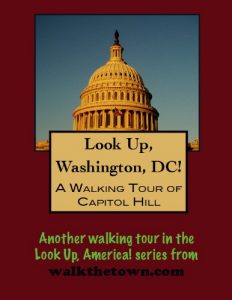There is no better way to see America than on foot. And there is no better way to appreciate what you are looking at than with a walking tour. Whether you are preparing for a road trip or just out to look at your own town in a new way.
Each walking tour describes historical and architectural landmarks and provides pictures to help out when those pesky street addresses are missing. Every tour also includes a quick primer on identifying architectural styles seen on American streets.
The Capitol Hill Historic District takes its name from the hill, which rises in the center of the Federal
City and extends eastward. This hill, which in 1790 was called Jenkins Hill or Jenkins Heights, was
the site chosen by Pierre L’Enfant for the placement of the “Congress House,” a site which L’Enfant
characterized as a “pedestal waiting for a superstructure.” In accordance with this plan, the US Capitol
Building was situated upon the crest of the hill facing the city. Stretching easterly behind the Capitol
Building along wide avenues lies the residential area known as Capitol Hill. Capitol Hill, one of the
oldest residential communities in Washington, has grown from a small boarding house community
for members of Congress to an area of more than 150 squares embracing a number of separate
neighborhoods.
Capitol Hill is the largest residential historic district in the District of Columbia. Almost every street
is composed of rowhouses of different stylistic varieties and periods forming a continuous wall broken
only by street intersections. Side by side exist early 19th century manor houses, Federal townhouses,
small frame dwellings, ornate Italianate bracketed houses and the late 19th century press brick
rowhouses with their often whimsical decorative elements combining Richardsonian Romanesque,
Queen Anne, and Eastlakian motifs.
In the early years of the Republic few Congressmen wished to establish permanent residence in the
city. Instead, most preferred to live in boarding houses within walking distance of the Capitol. Nothing
remains of this community today, having been razed to house the Capitol support buildings.Those
support buildings are indicative how the government has ballooned in recent times. For more than
100 years the business of Washington was conducted almost exclusively inside the Capitol Building
itself. The Supreme Court? Go to the Capitol. The Congressional library? Inside the Capitol. Your
representative’s office? Inside the Capitol. Today there are a half-dozen major office buildings and a few
satellites for the Congress alone. The Supreme Cout and library have their own buildings on the site of
many of those early boarding houses.
The street pattern in Capitol Hill has remained faithful to the original 1791 L’Enfant Plan for the
Federal City, a plan that called for grand diagonals superimposed over a standard grid pattern. East
Capitol Street, a monumental avenue running east from the Capitol to the banks of the Anacostia
River, still provides a major focus for the area and serves as the division between the northeast and
southeast sectors of the city. This walking tour will begin at the top of old Jenkins Hill...
Each walking tour describes historical and architectural landmarks and provides pictures to help out when those pesky street addresses are missing. Every tour also includes a quick primer on identifying architectural styles seen on American streets.
The Capitol Hill Historic District takes its name from the hill, which rises in the center of the Federal
City and extends eastward. This hill, which in 1790 was called Jenkins Hill or Jenkins Heights, was
the site chosen by Pierre L’Enfant for the placement of the “Congress House,” a site which L’Enfant
characterized as a “pedestal waiting for a superstructure.” In accordance with this plan, the US Capitol
Building was situated upon the crest of the hill facing the city. Stretching easterly behind the Capitol
Building along wide avenues lies the residential area known as Capitol Hill. Capitol Hill, one of the
oldest residential communities in Washington, has grown from a small boarding house community
for members of Congress to an area of more than 150 squares embracing a number of separate
neighborhoods.
Capitol Hill is the largest residential historic district in the District of Columbia. Almost every street
is composed of rowhouses of different stylistic varieties and periods forming a continuous wall broken
only by street intersections. Side by side exist early 19th century manor houses, Federal townhouses,
small frame dwellings, ornate Italianate bracketed houses and the late 19th century press brick
rowhouses with their often whimsical decorative elements combining Richardsonian Romanesque,
Queen Anne, and Eastlakian motifs.
In the early years of the Republic few Congressmen wished to establish permanent residence in the
city. Instead, most preferred to live in boarding houses within walking distance of the Capitol. Nothing
remains of this community today, having been razed to house the Capitol support buildings.Those
support buildings are indicative how the government has ballooned in recent times. For more than
100 years the business of Washington was conducted almost exclusively inside the Capitol Building
itself. The Supreme Court? Go to the Capitol. The Congressional library? Inside the Capitol. Your
representative’s office? Inside the Capitol. Today there are a half-dozen major office buildings and a few
satellites for the Congress alone. The Supreme Cout and library have their own buildings on the site of
many of those early boarding houses.
The street pattern in Capitol Hill has remained faithful to the original 1791 L’Enfant Plan for the
Federal City, a plan that called for grand diagonals superimposed over a standard grid pattern. East
Capitol Street, a monumental avenue running east from the Capitol to the banks of the Anacostia
River, still provides a major focus for the area and serves as the division between the northeast and
southeast sectors of the city. This walking tour will begin at the top of old Jenkins Hill...






